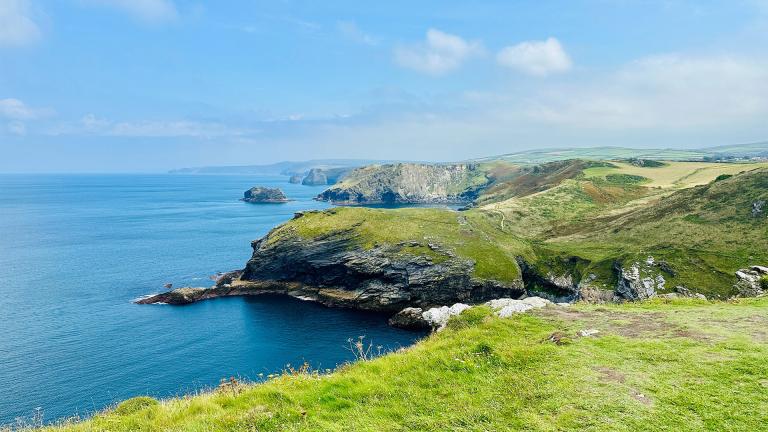
Read more about Medieval History

Tales of Arthur Pendragon’s life, death, and magical misadventures have captured hearts and minds since the 12th century. Geoffrey of Monmouth’s book The History of the Kings of Britain gave him legendary status as a ruler of Britain, Ireland, and parts of Europe. The obsession continues with cinematic portrayals by everyone from Disney to Guy Ritchie. It’s exciting stuff with knights, magicians, and a mysterious sword-wielding woman popping up anywhere there’s a damp patch.
The measure of truth behind these 5th-6th century tales is up for debate. Wales, Cornwall, and Dorset all lay claim to Arthur, making it hard to pinpoint locations of famous events, but here are five strong contenders.
The breathtaking headland at Tintagel in Cornwall was perfect for Monmouth’s depiction of King Uther Pendragon’s magical, and highly questionable, seduction of Duke Goloris of Cornwall’s wife. It even has caves below for the magician Merlin, who helped Uther appear as Golonis to trick Queen Igerna (later Igraine) into conceiving Arthur. In 1480, the antiquary William Worcestre also made Tintagel Arthur’s birthplace.
The castle was built by Richard, Earl of Cornwall in the 1230s. It appears Monmouth’s tales were the inspiration as there is no military value to the site. However, it wasn’t until 1650 that Tintagel Castle was first referred to as ‘King Arthur’s Castle’.
King Uther had many enemies and entrusted Arthur’s safety to Merlin, who secreted him away to London to live with Sir Ector. According to Robert de Boron’s Merlin, he also secured Uther’s sword (no not that one) into an anvil in a Westminster churchyard bearing the inscription:
‘Whosoever pulleth out this sword, is the right wise King born of all England’.
The anvil becoming a stone is perhaps a crossover with an Irish legend the Stone of Scone featuring Prince Artuir mac Aedan. As for the churchyard, wouldn’t Westminster Abbey be fitting? Sadly, it isn’t old enough. Many believe that the sword in the stone was further up the Thames outside a humble church that would be rebuilt as St Paul’s Cathedral.
The sword Arthur famously pulled was Caliburn. It was used by him until it broke during a duel with King Pellinore of Listenoise.
The castle where King Arthur held court and gathered knights to his round table features heavily in the legends, but there’s no record of a stronghold called Camelot, until Chrétien de Troyes’ Lancelot from 1180.
De Troyes also mentions Caerleon in South Wales, as does Geoffrey of Monmouth who suggests Arthur held court there. Thomas Malory goes further suggesting that Arthur was re-crowned there, while according to Gerald of Wales, ‘Roman ambassadors here received their audience at the court of the great King Arthur’.
Caerleon has a prime position on the River Usk, protected from the Severn but with access to the Channel. It also houses remains of an Iron Age hillfort occupied at least until the Roman conquest, as well as their legionary fortress Isca Augusta.
Another suggestion is that Arthur’s court was on the other side of the Severn, in Cadbury. While no poets wrote about it, there is an Iron Age hillfort on the River Cam that shows signs of heavy refortification in 470 AD. This would also put Camelot closer to Avalon.
Often shrouded with mist, Dozmary Pool on Cornwall’s Bodmin Moor is the perfect setting for a legend. Jan Treagle, fabled to have made a deal with the devil, was damned to dip all the water from the pool with a leaky limpet shell, but we’re not here for him.
Supposedly named after a murder victim, the pool is heralded as the lake Arthur rowed across to receive the sword Excalibur. The Lady of The Lake, Nimue, gave the sword in exchange for a boon she would later be beheaded for trying to claim.
As Arthur lay dying, the legends say that one of his knights, Sir Bedivere, returned Excalibur to the pool where a woman’s hand rose to claim it.
Arthur was famously killed by his own son Mordred during the Battle of Camlann. Monmouth puts this battle at Cornwall’s aptly named Slaughter Bridge on the River Camblam (now Camel), but the only battle fought here was in 823 AD. Camlann means 'crooked glen or bank' in Welsh and as such there are many locations in Wales by that name that could’ve been the battleground.
After his fatal injury, Arthur was taken to the magical isle of Avalon, the birthplace of the enchantress Nimue. Also known as the Isle of Glass it is widely believed that Avalon was Glastonbury Tor, which was previously an island.
A theory backed by the discovery of Arthur and Queen Guinevere’s remains at Glastonbury Abbey in 1191. It was reported by Gerald of Wales that the remains were found deep in the earth between two stone pyramids encoffined within a hollow oak, and that Arthur was ginormous. His tibia reached well above the tallest man’s knee, and his huge skull was peppered with multiple injuries. Arthur and Guinevere were reburied on the south side of the Lady Chapel in a black marble tomb fit for a once and future King.